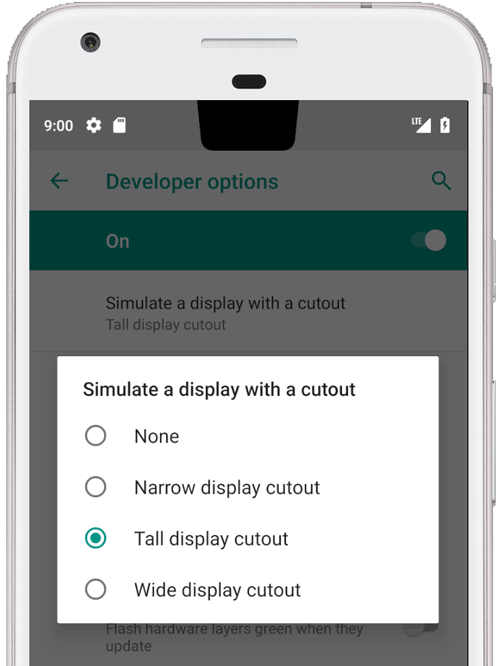Android 9 增加了对在设备上实现不同类型显示屏开孔的支持。显示屏开孔允许您创建沉浸式的边缘到边缘体验,同时仍为设备正面的重要传感器留出空间。

图 1. 顶部中心显示屏开孔
Android 9 支持以下类型的开孔
- 顶部中心:位于顶部边缘中心的开孔
- 顶部非中心:开孔可能位于角落或稍微偏离中心
- 底部:位于底部的开孔
- 双开孔:顶部和底部各一个开孔
示例和源代码
PhoneWindowManager.java 中的以下窗口管理器代码展示了当未设置 LAYOUT_IN_DISPLAY_CUTOUT_MODE_ALWAYS 时,显示帧如何嵌入到安全区域。
// Ensure that windows with a DEFAULT or NEVER display cutout mode are laid out in
// the cutout safe zone.
if (cutoutMode != LAYOUT_IN_DISPLAY_CUTOUT_MODE_ALWAYS) {
final Rect displayCutoutSafeExceptMaybeBars = mTmpDisplayCutoutSafeExceptMaybeBarsRect;
displayCutoutSafeExceptMaybeBars.set(displayFrames.mDisplayCutoutSafe);
if (layoutInScreen && layoutInsetDecor && !requestedFullscreen
&& cutoutMode == LAYOUT_IN_DISPLAY_CUTOUT_MODE_DEFAULT) {
// At the top we have the status bar, so apps that are
// LAYOUT_IN_SCREEN | LAYOUT_INSET_DECOR but not FULLSCREEN
// already expect that there's an inset there and we don't need to exclude
// the window from that area.
displayCutoutSafeExceptMaybeBars.top = Integer.MIN_VALUE;
}
if (layoutInScreen && layoutInsetDecor && !requestedHideNavigation
&& cutoutMode == LAYOUT_IN_DISPLAY_CUTOUT_MODE_DEFAULT) {
// Same for the navigation bar.
switch (mNavigationBarPosition) {
case NAV_BAR_BOTTOM:
displayCutoutSafeExceptMaybeBars.bottom = Integer.MAX_VALUE;
break;
case NAV_BAR_RIGHT:
displayCutoutSafeExceptMaybeBars.right = Integer.MAX_VALUE;
break;
case NAV_BAR_LEFT:
displayCutoutSafeExceptMaybeBars.left = Integer.MIN_VALUE;
break;
}
}
if (type == TYPE_INPUT_METHOD && mNavigationBarPosition == NAV_BAR_BOTTOM) {
// The IME can always extend under the bottom cutout if the navbar is there.
displayCutoutSafeExceptMaybeBars.bottom = Integer.MAX_VALUE;
}
// Windows that are attached to a parent and laid out in said parent already avoid
// the cutout according to that parent and don't need to be further constrained.
// Floating IN_SCREEN windows get what they ask for and lay out in the full screen.
// They will later be cropped or shifted using the displayFrame in WindowState,
// which prevents overlap with the DisplayCutout.
if (!attachedInParent && !floatingInScreenWindow) {
mTmpRect.set(pf);
pf.intersectUnchecked(displayCutoutSafeExceptMaybeBars);
parentFrameWasClippedByDisplayCutout |= !mTmpRect.equals(pf);
}
// Make sure that NO_LIMITS windows clipped to the display don't extend under the
// cutout.
df.intersectUnchecked(displayCutoutSafeExceptMaybeBars);
}
SystemUI 在开孔区域中渲染,并且需要确定可以在何处绘制。PhoneStatusBarView.java 提供了一个视图示例,该视图确定显示屏开孔的位置、大小以及来自导航栏的嵌入是否避开了开孔区域。
通过重写 onApplyWindowInsets(),视图可以确定凹口的位置并相应地更新其布局。
@Override
public WindowInsets onApplyWindowInsets(WindowInsets insets) {
if (updateOrientationAndCutout(mLastOrientation)) {
updateLayoutForCutout();
requestLayout();
}
return super.onApplyWindowInsets(insets);
}
这些方法概述了在所有情况下(即顶部居中、顶部未居中、底部以及所有旋转方向的双凹口)状态栏中如何处理凹口。
要求
为确保应用不受凹口的不利影响,您必须确保:
- 在纵向模式下,状态栏至少延伸到凹口的高度
- 在全屏和横向模式下,凹口区域必须采用信箱模式
您的设备在每个短边(顶部和底部)最多可以有一个凹口。
如需了解详情,请参阅 CDD。
实现
要在您的设备上实现显示屏凹口,您必须为 System UI 配置以下值。
| 值 | 说明 |
|---|---|
quick_qs_offset_height
|
定义快速设置面板的顶部边距。时钟和电池显示在面板上方的空间中。 在 values-land 中,设置为 |
quick_qs_total_height
|
当通知阴影展开时,快速快速设置面板(折叠的快速设置面板)的总高度,包括面板上方包含时钟的空间。 由于快速设置的布局方式,快速快速设置面板的总高度(包括偏移量)必须是静态已知的,因此必须通过相同的增量 |
status_bar_height_portrait
|
从框架的角度来看,状态栏的默认高度。 在大多数设备中,此值默认为 24dp。当存在凹口时,将此值设置为凹口的高度。如果需要,可以比凹口更高。 |
status_bar_height_landscape
|
横向模式下状态栏的高度。凹口仅在设备的短边上受支持,因此这将始终是不更改的状态栏高度。 在没有凹口的设备中,这等同于 |
config_mainBuiltInDisplayCutout
|
定义凹口形状的路径。这是一个可由
|
config_fillMainBuiltinDisplayCutout
|
一个布尔值,用于确定是否在软件中绘制凹口路径(如上定义)。可用于模拟凹口,或填充物理凹口以实现抗锯齿。 如果为 true,则 |
请参阅这些 dimens 文件以了解默认定义
用于模拟凹口的示例叠加层
<resources xmlns:xliff="urn:oasis:names:tc:xliff:document:1.2">
<!-- The bounding path of the cutout region of the main built-in display.
Must either be empty if there is no cutout region, or a string that is parsable by
{@link android.util.PathParser}.
The path is assumed to be specified in display coordinates with pixel units and in
the display's native orientation, with the origin of the coordinate system at the
center top of the display.
To facilitate writing device-independent emulation overlays, the marker `@dp` can be
appended after the path string to interpret coordinates in dp instead of px units.
Note that a physical cutout should be configured in pixels for the best results.
-->
<string translatable="false" name="config_mainBuiltInDisplayCutout">
M 0,0
L -48, 0
L -44.3940446283, 36.0595537175
C -43.5582133885, 44.4178661152 -39.6, 48.0 -31.2, 48.0
L 31.2, 48.0
C 39.6, 48.0 43.5582133885, 44.4178661152 44.3940446283, 36.0595537175
L 48, 0
Z
@dp
</string>
<!-- Whether the display cutout region of the main built-in display should be forced to
black in software (to avoid aliasing or emulate a cutout that is not physically existent).
-->
<bool name="config_fillMainBuiltInDisplayCutout">true</bool>
<!-- Height of the status bar -->
<dimen name="status_bar_height_portrait">48dp</dimen>
<dimen name="status_bar_height_landscape">28dp</dimen>
<!-- Height of area above QQS where battery/time go (equal to status bar height if > 48dp) -->
<dimen name="quick_qs_offset_height">48dp</dimen>
<!-- Total height of QQS (quick_qs_offset_height + 128) -->
<dimen name="quick_qs_total_height">176dp</dimen>
</resources>
验证
要验证显示屏凹口的实现,请运行位于 tests/framework/base/windowmanager/src/android/server/wm 的 CTS 测试。
